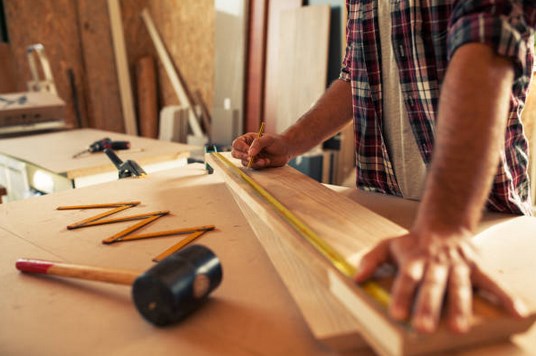5 Woodworking Tips For Beginners - 4 minutes read
Here are 5 top tips to follow as a woodworker who is just getting started on a new hobby or business. Following these tips will give you a great foundation to get started!
1. Know Your Wood. There are many different types of wood with different characteristics. Knowing the different types of wood, how to care for and treat it, and how it will react in different environments is key. Each type of wood will have different moisture content. The amount of moisture will affect how stain, paint, and glue takes to it. This is key because if you stain a piece of oak and a piece of pine with the same color stain, you will yield different results. The wood will take the stain differently and show a different color.
2. Pre-drill Screw Holes. When using a screw to attach a piece of wood to a surface pre-drilling the hole is a good idea. Depending on how thick the wood is or how close you are to the edge, you can risk the board splitting from the pressure. Having a board split on you during assembly is one of the most frustrating things about being a woodworker. By pre-drilling, the board with a hole slightly smaller than the screw will eliminate this issue. One key thing to keep in mind is to use a countersink screw head. The countersink feature allows for a slightly larger opening at the top of the bit. This will widen the pre-drilled hole to allow the screw head to be recessed in the board. Failure to use a bit like this may lead to a cracked board even with pre-drilling. This bit will also give you the option to plug the hole to hide the screw head.
3. Use Stop-Block. The stop block is a quick way to make precise cuts on boards when you are cutting multiples of the same size. The stop block can be secured to a saw to set the length of the board you need to cut. Once set, you can butt the pieces of wood that need to be cut right up to the block to get the same cut every time. This makes for a quick and accurate method of cutting multiple boards.
4. Use a Jig. Whether you are making pocket angle holes or just installing cabinet pulls, a jig is a great time saver. Using a jig gives you a template for consistent and even holes on different pieces of wood. A nice example of using a jig is when installing cabinet pulls on your kitchen cabinets. If you are able to make an angle jig that matches the corners of your cabinet, you can pre-drill the hole in the same spot each time. This eliminates the time you would spend measuring and marking each spot.
5. Plan Your Project. Last but not least, having a plan and a drawing of your project beforehand will really make for a smoother experience. Planning will also help with budgeting your time and money and will also help with making sure you are getting all of the supplies required for the project. Mapping out your project will help foresee any issues with the assembly of the project while allowing for any adjustments to be made prior to assembly. If you wait until then, you risk a loss of materials and your time. It is also a good idea to think about what tools you will need for the project. Planning this part out will help avoid getting to a point in your project where you need a tool and don’t have it. This will delay your project and push back your timeline potentially costing you more money.
Following these simple steps to start your woodworking adventure will not only give you a great foundation to start each project but also for building your new business or hobby. And as always, remember to follow all safety procedures and to abide by the manufacturer’s recommendations for each tool you use.
Get instant access to thousands of high quality woodworking plans and projects
Here’s are the plan categories:
There are quite a few plans in each category.


